Abstract
Brucellosis is a common zoonosis, which still remains as a major health problem in certain parts of the world. Spondylodiscitis is the most frequent osteoarticular complication of brucellosis. Herein is reported an uncommon case of a middle-aged male treated for brucellosis who developed 2 years after the treatment brucellar spondylodiscitis complicated by a psoas muscle abscess, an infected abdominal aorta aneurysm and deep venous thrombosis of IVC, common iliac, external iliac and common femoral veins. CT and CT angiography were the imaging modalities depicting the findings. After an endovascular stent graft placement in abdominal aorta aneurysm, a CT guided drainage of retroperitoneal abscess revealed Brucella melitensis as the pathogen microorganism. Diagnosis of spondylodiscitis and contiguous psoas abscess is usually simple but aortic involvement is difficult to identify and can be easily overlooked. A high degree of suspicion is essential to reduce the delay for the treatment.
Résumé
La brucellose est une zoonose qui continue de représenter un problème majeur de santé publique dans plusieurs pays du monde. La spondylodiscite est la plus fréquente complication ostéo-articulaire de la brucellose. Le cas rapporté ici est celui d’une forme inhabituelle chez un homme d’âge moyen qui a présenté deux ans après traitement une spondylodiscite brucellienne compliqué d’un abcès du psoas, un anévrisme infecté de l’aorte abdominale et une thrombose veineuse profonde de la veine cave inférieure, des veines iliaque commune, iliaque externe et des veines fémorales communes. Le scanner et l’angioscanner ont permis le diagnostic. Après mise en place endovasculaire d’un stent dans l’anévrisme aortique, l’analyse bactériologique du produit de drainage de l’abcès rétropéritonéal, drainage guidé par scanne, révéla la présence de Brucella melitensis. Le diagnostic de la spondylodiscite brucellienne et d’un abcès du psoas contigu est habituellement facile, mais l’implication d’un anévrisme aortique est difficile à reconnaître et peut être méconnu. Un haut degré de suspicion est essentiel pour diminuer le délai de mise en route du traitement.




Similar content being viewed by others
References
Aguado JM, Barros C, Gomez Garces JL, Fernandez-Guerrero ML (1987) Infective aortitis due to Brucella melitensis. Scand J Infect Dis 19(4):483–484
Andrew WK (2000) An unusual cause of deep venous thrombosis of the lower limb. S Afr Med J 90(1):42
Bennet DE (1967) Primary mycotic aneurysms of the aorta. Report of case and review of the literature. Arch Surg 94(6):758–765
Bergeron P, Gonzales-Fajardo J, Mangialardi N, Courbier R (1992) False aneurysm of the abdominal aorta due to Brucella suis. Rev Ann Vasc Surg 6(5):460–463
Cano Trigueros E, Carranza Martinez JM, Perez Garcia E et al (1997) A digestive hemorrhage due to an aortoduodenal fistula secondary to an aortic aneurysm of brucellar etiology. Review. Span Rev Esp Enferm Dig 89(9):728–729
Colmenero JD, Reguera JM, Martos F et al (1996) Complications associated with Brucella melitensis infection: a study of 530 cases. Medicine (Baltimore) 75(4):195–211
Fudge TL, Ochsner JL, Ancalmon N et al (1977) Surgical resection of multiple aortic aneurysms due to Brucella suis. Surgery 81:236–238
Gillet M, Sava P, Cassou M et al (1983) Aneurysmes infectieux de l’aorte sous-renale: reflexions a propos de deux cas d’etiologie brucellienne. Chirurgie 109:168–172
Koeppel TA, Gahlen J, Diehl S et al (2004) Mycotic aneurysm of the abdominal aorta with retroperitoneal abscess: successful endovascular repair. J Vasc Surg 40(1):164–166
Marfil-Rivera LJ, Marez-Ramirez MA, Mora-Brondo P et al (1986) Deep venous thrombosis in a patient with Brucellosis and a probable lupoid inhibitor. Rev Invest Clin 38(3):311–315
Maurin M (2005) Brucellosis at the dawn of the 21st century. Med Mal Infect 35(1):6–16
Memish ZA, Bannatyne RM, Alshaalan M (2001) Endophlebitis of the leg caused by brucella infection. J Infect 42(4):281–283
Moriarty JA, Edelman RR, Tumeh SS (1992) CT and MRI of mycotic aneurysms of the abdominal aorta. J Comput Assist Tomogr 16(6):941–943
Muller BT, Wegener OR, Grabitz K et al (2001) Mycotic aneurysms of the thoracic and abdominal aorta and iliac arteries: experience with anatomic and extra-anatomic repair in 33 cases. J Vasc Surg 33(1):106–113
Odeh M, Pirk N, Ollven A (2000) Deep venous thromobosis associated with acute Brucellosis. A case report. Angiology 51(3):253–256
Oderich GS, Panneton JM, Bower TC et al (2001) Infected aortic aneurysms: aggressive presentation, complicated early outcome, but durable results. J Vasc Surg 34(5):900–908
Quaniers J, Durieux R, de Leval L, Limet R (2005) Abdominal aortic aneurysm due to Brucella melitensis. Acta Chir Belg 105(1):93–95
Quilchini F, Tournigand P, Mercier C (1974) Les aneurysms rompus de l’aorte abdominale. J Chir 108:351–368
Reddy DJ, Ernst CB (2000) Infected aneurysms. In: Rutherford RB (ed) Vascular surgery, 5th edn. W.B. Saunders, Philadelphia, pp 1383–1397
Rubery PT, Smith MD, Cammisa FP, Silane M (1995) Mycotic aortic aneurysm in patients who have lumbar vertebral osteomyelitis. J Bone Joint Surg Am 77A:1729–1732
Sava P, Camelot G, Miguet JP (1977) Aneurysme de l’aorte abdominale et brucellose: a propos d’un nouveau cas opera avec success. Ann Chir Thorac Cardiovasc 16:221–225
Solera J, Lozano E, Martinez-Alfaro E et al (1999) Brucella spondylitis: review of 35 cases and literature survey. Clin Infect Dis 29(6):1440–1449
Ting AC, Cheng SW, Pei Ho et al (2005) Surgical treatment of infected aneurysms and pseudoaneurysms of the thoracic and abdominal aorta. Am J Surg 189(2):150–154
Walsh DW, Ho VB, Haggerty MF (1997) Mycotic aneurysm of the aorta: MRI and MRA features. J Magn Reson Imaging 7(2):312–315
Yee N, Roach D (1996) Infected abdominal aortic aneurysm caused by spinal brucellar infection. Am J Roentgenol 167(4):1068–1069
Young E (1995) An overview of human brucellosis. Clin Infect Dis 21(2):283–289
Author information
Authors and Affiliations
Corresponding author
Rights and permissions
About this article
Cite this article
Kokkinis, K., Stathopoulou, S., Petrocheilou, G. et al. Brucella spondylitis complicated by an infected abdominal aortic aneurysm and deep venous thrombosis: case report and review of the literature. Eur J Orthop Surg Traumatol 18, 23–27 (2008). https://doi.org/10.1007/s00590-007-0256-7
Received:
Accepted:
Published:
Issue Date:
DOI: https://doi.org/10.1007/s00590-007-0256-7




